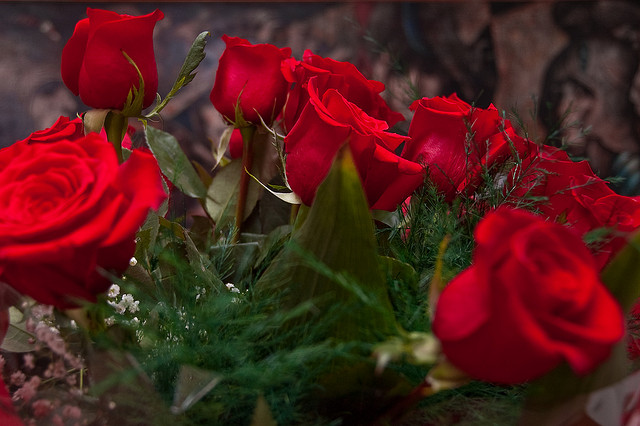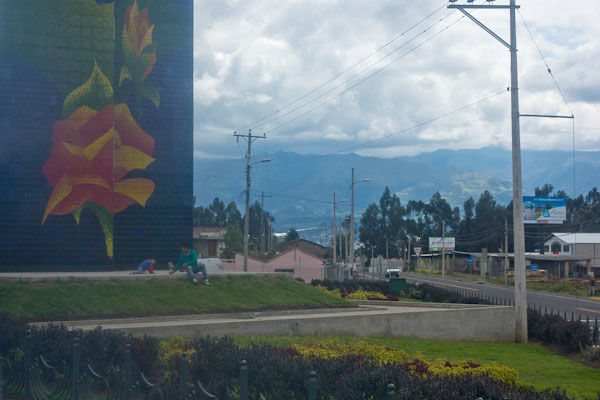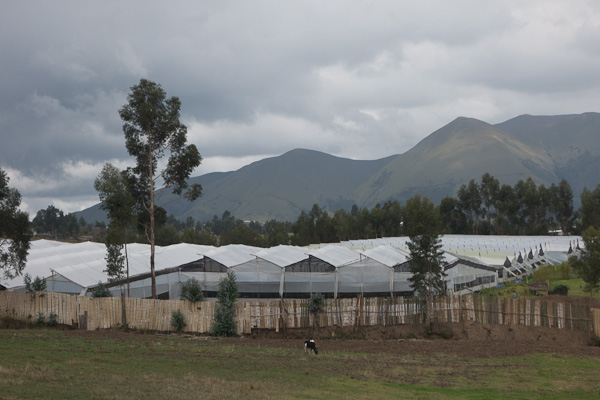It’s Valentines Day, so everywhere I go vendors have popped up to sell cellophane-wrapped gift baskets, pink teddy bears, and bunches of red long stem roses. I never thought about where these roses came from until we visited Ecuador last year.

Almost all of the long stem roses sold in the US come from South America, and most of those roses come from Ecuador. There are two reasons for this. First, roses grow perfectly straight only near the equator where the sun shines perpendicular to the plan. Second, the high-altitude of the equatorial regions near Quito also offer powerful solar radiation that makes flowers grow to be heartier, with thicker stems and even, vibrant colors. Because of this combination of factors, vendors who sell roses from Ecuador are considered among the finest in the world.

Ecuadorian greenhouses, seen from the air
When we traveled from Quito to the indigenous market city of Otavalo, our bus passed through the heart of the county’s rose industry. Rows of greenhouses blanket the landscape for many miles. It’s clear this industry is the lifeblood of these communities. One municipality we passed had a sign depicting the name of the town and it’s motto, “Pedro Moncayo: Rose Capital of the World.” We didn’t get to visit the main town in the region, Cayambe, but another traveler told us that it has a nice cut-flower market, though I assume, the best flowers are reserved for export.

Rose monument in Pedro Moncayo, Ecuador
The industry dominates this region and the local economy has flourished from the global rose trade. Over 80% of all workers in the province work in the rose industry, and the global growth in demand (highest near Valentines Day and Mother’s Day) has brought economic improvements to the previously impoverished region.

Greenhouses in Pedro Moncayo, Ecuador
But as with any rapid economic development, there are downsides for workers and the communities. These large growers often rely on heavy doses of toxic pesticides, fungicides, and fumigants to grow perfect and unblemished roses. Companies often don’t provide necessary protective gear to workers, and this exposure poses serious risks to the workers that are surrounded by them all day, every day. These pollutants often make their way into the local water supply, exacerbating these health concerns.
If you are concerned about the working conditions and environmental impact of the flowers you buy, look for Fair Trade Certified or Veriflora Certified flowers. This international inspection organizations ensure partner manufacturers provide fair compensation, safe working conditions, and a less polluting production process.
I don’t regularly buy cut-flowers–I prefer living plants that I can enjoy longer–but when I do, I’ll be looking for those logos.
Photo source: Roses via Flickr/sylvia
Thank you for the informative and considerate posting of aspects of long stem roses I had not even thought to ask in my Google query..”where do long stem roses come from in January”.
Hello. I am a greenhouse owner located in the USA and have been in the horticultural industry my entire life. There are a few things in your post that are very inaccurate. First off, the belief that roses grow straight stems in Ecuador because it is located on the equator is a complete myth. Many years ago we grew cut roses at our greenhouses and the stems were perfectly straight. I grow tea roses outdoors as a hobby. I have perfectly straight roses. The stems are straight due to the selection and breeding of varieties that exhibit that specific trait, and due to the way the roses are pruned and trained to grow in the greenhouse. The high altitude and cooler temps do help the roses to have stronger stems, as the cooler temps slow the growth down some. Also, the equator gets fairly steady solar radiation year round. The day length varies from season to season by about 2-3 minutes! But, in the northern hemisphere summer our roses will actually have faster growth. That’s because the day length here in summer is over 14 hours. It’s even more the further north you go. When we would grow roses in the greenhouse in winter, the growth would slow significantly. Ultimately, what made the cut flower industry flourish in Ecuador is due to $$$$. They do not have the expense of heating their greenhouses for 7-8 months of the year. Another big one is labor cost savings. It’s the same reason that manufacturing jobs left and went overseas. Cut costs as much as possible. Free trade agreements mean no tariffs to protect domestic production. We could grow roses that were high quality year round, with straight stems too. But, the domestic cut flower industry couldn’t compete with the low cost production in Ecuador. Nor could we compete with European or Canadian cut flowers and plants. Their horticultural operators are subsidized under agricultural farm support subsidy programs. US horticulture receives not a single dime in subsidy under the US farm subsidy program. So while Ecuador built lots of new greenhouses that brought benefit to their communities, lots of small family owned greenhouses closed up shop all over the US. Years ago my grandfather and several of his brothers all had greenhouses. All of the existing buildings at my grandfather’s greenhouse (now it’s mine) were built with money almost exclusively from cut flowers. They made decent money growing them. But once the 90’s rolled around, the cut flower production industry in the US dried up almost completely. Fortunately we have survived by transitioning to annual bedding plants and hanging baskets. We also were blessed to be located on a very busy highway with tons of visibility. That has allowed us to turn into an almost exclusively retail operation. But, we still have long stretches of no income since the annuals are a once a year thing and no cut flowers. We haven’t found a viable replacement for the cut flowers yet in order to supplement our current income. We barely break even most years but at least we keep the bills paid. Anyhow, just wanted to correct the earlier errors in your article and to give you a background on the cut flower industry from the perspective of a professional greenhouse owner-operator. Thank you!!!